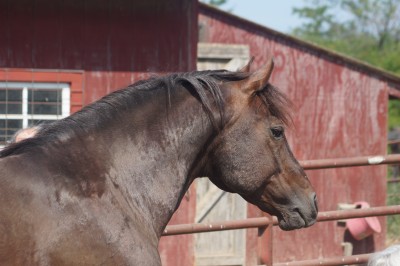Clarion CF recent shots
Last week Kirby Drennan sent me pictures of her Clarion CF (Regency CF x Chinoiserie by Dharanad) which Anita Westfall had taken some time before. Here is one, which shows the stallion’s large eyes, his protruding facial bones, and his especially deep jaws. These are typical features of a Davenport stallion, and they are particularly prominent in Clarion. These are also the features of a desert bred stallion in its homeland. The second photo shows the distribution of the horse’s musculature.


Thanks Edouard and Kirby. These are interesting photos. Clarion CF appears to be one of those unique chestnuts with a very dark mane an tail. He reminds me of Ibn Sirecho (Sirecho x Turfara) a stallion born in 1961 who I saw and filmed and owned a daughter of. He was of similar coloration where you had to look close to be certain that he wasn’t bay. Tom McNair of Gleannloch farms told me many years ago that there are some bays that start out looking like chestnuts and then as they age confirm that they are bay and others who remain chestnut as they age as the body and mane later become closer in tone. We had an Al Metrabbi filly who looked like Clarion’s color as a filly but she eventually turned a verifiable bay which is how we registered her. Tom McNair said that these exceptions and variations are considered rare but they are very old colors and are appreciated by the Arabs, based on his time in the Middle East in the 1960s.
Examining the hair color at the horse’s coronet bands and pasterns is one way to determine whether a horse is dark chestnut or bay.
It seems that every so often in the past there were those debates about whether chestnut or bay, perhaps without really investigating thoroughly before registering. Our Al Metrabbi daughter was eventually registered as bay but I can assure you that her legs, mane and tail really looked like very dark liver chestnut but eventually turned black but it took 2 years!!! However we were told by Lazelle Atkinson, who owned the sire to go ahead and register as bay and wait and she was right.
Now this makes me wonder about ancestors of the past. Many know about the debate about Domow, being confirmed bay while believed to be out of the two chestnuts, Abu Zeyd and Wadduda or at least registered as such. But what about the Al Khamsa mare Lulu, a 1936 registered bay, being sired by the chestnut stallion Asil and out of the chestnut mare Aatika? I am wondering if in the past there were some other truly borderline examples who looked bay but really were a rare form of chestnut? Ibn Rabdan was verified as chestnut but was really very dark, and some of the old Egyptian descendants come out so dark chestnut as to appear near black. Any ideas R.J or Michael?
There surely are light bays as well as dark chestnuts, and there are also registered colors which are incorrect. RJ and I actually address the case of Aatika in our “Reconstructing Domow” piece, since she represents a link of the Domow E allele from the bay Tabab (sire of Aatika) to Lulu.
There is at least one picture of Aatika where she does appear to be bay, within the limits of black and white photography. Aatika’s last owners were the Asmises of Never Die Farm in Maryland, and Helene Asmis Clifford confirmed that Aatika was a bay. We included this information in support of the correct recording of Domow’s own color.
Thanks Michael. That is helpful. Perhaps Aatika went through the same color evolution period as my Al Metrabbi daughter. Al Meerida could have easily been registered as chestnut if we were in a hurry and did not ask Lazelle Atkinson about the color issue since she had experienced this color phenomenon before. Once these kind of horses are mature their true color must be evident so that would explain some of the errors of the past.
Of course the Egyptian records are notorious for color errors when they register colors of foals when they are very young. Even the old mare Tarfa c. 1900 of Ahmed Pasha Kemal was recorded as grey when later the Prince Mohammed Ali scrapbook photos in the collection of Judith Forbis verified that she was a chestnut.
Also, if a horse has the less common coat color variations such as “wild bay”, pangare (“mealy”),or “sooty”, it may be difficult to determine the base color.
Bonne Femme was a similar color to Clarion, but she was really a light (wild) bay and Clarion is really a liver chestnut. Life is so fascinating!